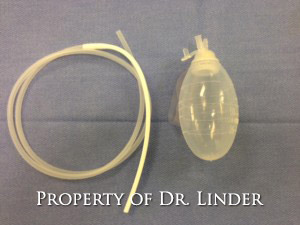SEROMA FORMATION AFTER TUMMY TUCK
Posted On: April 19, 2013 Author: The Office of Dr. Stuart Linder Posted In: Body Sculpting, Panniculectomy, Tummy Tuck
Patients after tummy tuck (abdominoplasty) procedure may present with multiple complications, one of which is a seroma. Seroma is a complication that may occur in up to 1 to 2 percent of abdominoplasties, especially large paniculectomies. In my opinion, in order to reduce this risk complication, it is important to drain the abdominal cavity. In the majority of tummy tucks (abdominoplasties) I use 10 mm Jackson-Pratt drains; however, with large paniculectomies at least three drains will be place, one on each hip and one in the suprapubic region. Removing the drain is easy and usually is performed at the office setting between postop day 7 and day 10, depending upon the amount of drainage fluid. Normally, I wait until there is less than 24 cc of drainage fluid in a 24-hour period before removing the drain and usually not less than 7 days after the initial surgery. Seroma formation is associated with fluid that forms in an open abdominal space. This can occur anywhere in the body where there is an open space that has been created surgically, including a breast pocket. For example, when implants are removed, the pocket may create a seroma and therefore a drain should be placed as well. Seromas are the serous fluid that the body creates within the cavity. These can be painful on examination. The serous fluid can find its way out either through the incision or it can be resorbed back through the body. Small seromas are actually quite common and resorb within the body and are uneventful. Large seroma, however, may be painful and expanding along the lower abdominal wall and require aspiration and/or secondary trips to the operating room with drainage tube placement.
In my practice, I have seen very few seromas in that we do using the drainage tubes for 7 to 10 days as well as we are very thorough on our hemostasis along the abdominal wall. Opening of just enough tissue up to the subcostal margins in order to allow for the abdominal flap to be lowered and removed is important. Excessive dissection above the subcostal margin or the ribcage can lead to increased seroma formation. Lymphatics can also be disturbed in the inguinal area (the groin crease area) which could lead to lymphatic fluid formation and seromas. Therefore, care should be taken on dissection along the inguinal area and along the groin region and suprapubic region toward the femoral area. Seromas can be identified either clinically if large, a manual wave can be identified on clinical examination by palpation of the abdomen and if not certain, an ultrasound can be performed in order to determine specifically where the loculation of fluid collection is for aspiration either directly or through ultrasonic aspiration.
